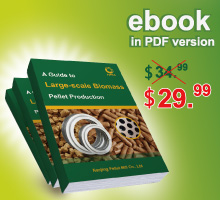Firstly, it depends on the raw materials at your hand. If it is sawdust and shavings, the size of them have to be able to get through the die holes with the diameter ranging from 8mm to 12mm. (If you have branches or the discarded wood board as the raw materials just like many of our clients do, then the pulverization is needed.) Secondly, the water content of the raw materials is required to be around 10% to 16% with the deviation no more than 2 to 4%. If the water content of your raw materials is larger than that of the requirement, we will provide the most suitable drying equipment for you. If the water content of the raw materials is lower than that of the requirement, relatively high water content materials are needed to mix with the raw materials in order to meet the requirement for water content.
In conclusion, the production line consists of the processing procedures of pulverizing, drying, mixing, pelletizing, package, and accessory systems such as electrical control system, pulverizing pretreatment system, conveying system, temperature control system, etc.
The host machine of the pelletizing system is the ring die pellet mill, also called round die pellet mill, mainly consists of the vertical ring die and the inner rotary drum, with the latter exerting pressure on the former. In the conveying system, the raw materials are transported to the center of the pelletizing chamber by a fan propeller. In the pelletizing chamber, the rotary drum, which consists of roller and shaft, is static while the ring die is dynamic, similar with the working principle of a washing machine. The raw materials are pressed through the ring die holes. And then come the pellets. Ring die pellet mill is usually applied in the large scale pellet production line for the two reasons. One is it causes relatively low loss for the rotary drum, and the other is it has a higher energy utilization rate, comparing with the flat die pellet mills which consume more energy because of the abrasion caused by the sliding of the rotary drum. ABC Machinery pellet mills take advantage of air circulation to control the temperature and expel the surplus water vapor, cooling the temperature from more than 200 ℃ down around 80℃ to 100℃, lowering the temperature stress posed to the ring die to a large extent, improving the working environment in the non-pelletizing area, and eventually extending the serving life of the ring die and roller shaft, making the continuous production into reality, and lowering the production cost effectively by extending the working life of ring die higher up to 800 to 1000 tons from 250 to 300 tons.

